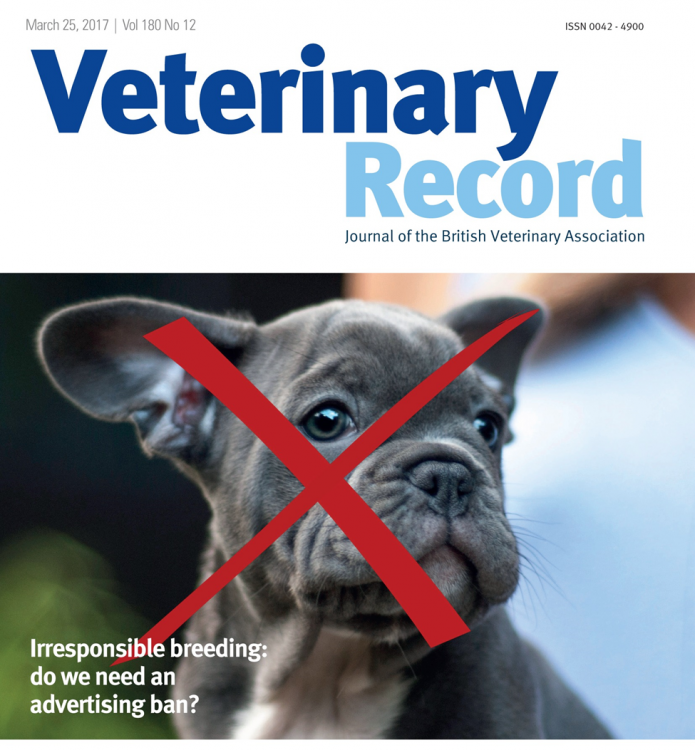Veterinary Record: "Brachycephalic tipping point: time to push the button? "
 Health and welfare issues continue to be in media, with a comment in the latest issue of The Veterinary Record entitled "Brachycephalic tipping point: time to push the button?" and a report: "It's now time to curb advertising using flat-faced dogs, say vets". The latter has comments from industry representatives, researchers, vets and others. Many in the UK are alarmed at the burgeoning popularity of these dogs. As Caroline Kisko, of The Kennel Club states, for all breeds, less than a third of these dogs are registered/ come under the umbrella of The KC. Which means the vast majority are bred by those who do not participate in health programs of the registering body; the same is true in many countries. And although most attention (and blame) is directed towards breeders of pedigree dogs, it may be that, globally, the major source of these dogs is commercial breeders. Regardless, it seems that unless we can influence those acquiring these dogs (consumers) it is unlikely that the numbers can be markedly reduced. Why do so many people want these dogs in spite of many attempts over numerous years to educate them to the potential problems?
Health and welfare issues continue to be in media, with a comment in the latest issue of The Veterinary Record entitled "Brachycephalic tipping point: time to push the button?" and a report: "It's now time to curb advertising using flat-faced dogs, say vets". The latter has comments from industry representatives, researchers, vets and others. Many in the UK are alarmed at the burgeoning popularity of these dogs. As Caroline Kisko, of The Kennel Club states, for all breeds, less than a third of these dogs are registered/ come under the umbrella of The KC. Which means the vast majority are bred by those who do not participate in health programs of the registering body; the same is true in many countries. And although most attention (and blame) is directed towards breeders of pedigree dogs, it may be that, globally, the major source of these dogs is commercial breeders. Regardless, it seems that unless we can influence those acquiring these dogs (consumers) it is unlikely that the numbers can be markedly reduced. Why do so many people want these dogs in spite of many attempts over numerous years to educate them to the potential problems?
We have focused on health and welfare issues for brachycephalic breeds in various articles on DogWellNet.com. And as discussed in a recent research article, acquisition of dogs may not be driven as much by prospective health or welfare, as by owner preferences. I have highlighted the factors influencing choice of breeds in many talks over the years and other blogs, and it is obvious that consumers are heavily influenced by the popularity of breeds in the media, movies, popular culture, etc. It seems there is, in general, an underlying need for many people to 'stand out' by owning the most popular, most extreme, biggest, fastest - whatever - and those attitudes may lead to them wanting extreme dogs. Can it be that consumers still don't know these dogs are at risk? Might it even be, in some cases, that people want to take on a potentially compromised dog and see themselves in the role of "extreme" care-giver?
As for the Veterinary Record decision, most of us are, in general, not fond of across-the-board breed bans that tend to impact all dogs or owners, not just the 'worst'. However, The Vet Record comment makes a good case for their decision. Although not specifically mentioned, this decision moves on from recommendations about the use of compromised dogs/ breeds in the media brought to the forefront by CRUFFA (The Campaign for the Responsible Use of Flat-Faced Animals, on Facebook) over the past several years. Jemima Harrison (Pedigree Dogs Exposed - The Blog) has been a tireless, if controversial campaigner on this issue and is the creator of the CRUFFA page.

 And there are some pretty scary images out there online... obviously chosen because they are thought to be particularly cute or funny, but which may actually represent anatomical issues of great concern. Like this one (left) on a pet business website. And one (right) I found years ago on a site called FunnyDogSite.com. Not funny, actually ... the dog is in that position so that it can sleep without passing out. This dog on the right is also challenged by its obesity.
And there are some pretty scary images out there online... obviously chosen because they are thought to be particularly cute or funny, but which may actually represent anatomical issues of great concern. Like this one (left) on a pet business website. And one (right) I found years ago on a site called FunnyDogSite.com. Not funny, actually ... the dog is in that position so that it can sleep without passing out. This dog on the right is also challenged by its obesity.
What perhaps needs to be done, beyond restricting advertising, is to try to address the considerable influence of celebrities on consumer choice of breeds. It is likely that concerted, evidence-based education programs warning consumers about problems in certain breeds, go unnoticed or at least pale in the face of, e.g. one instagram post of a desirable celeb with a French Bulldog.
As we try to move from simply informing the public to actually changing behaviours around health and welfare of dogs, we must all search for creative and effective ways to communicate. To do so, we must know what are the most important influencers of human behaviour and how to 'tip' the situation to the better.
At the IPFD 3rd International Dog Health Workshop to be held in Paris, 21-23 April 2017 we have a Theme devoted to Health and Welfare Issues of Extreme Conformation. Experts, breeders, veterinarians ... decision-makers from various stakeholder groups will come together to discuss the work being done nationally and internationally to address these problems and to identify collaborative international actions that will help advance the health and welfare of these beloved dog breeds.
 Donate
Donate


0 Comments
Recommended Comments
There are no comments to display.